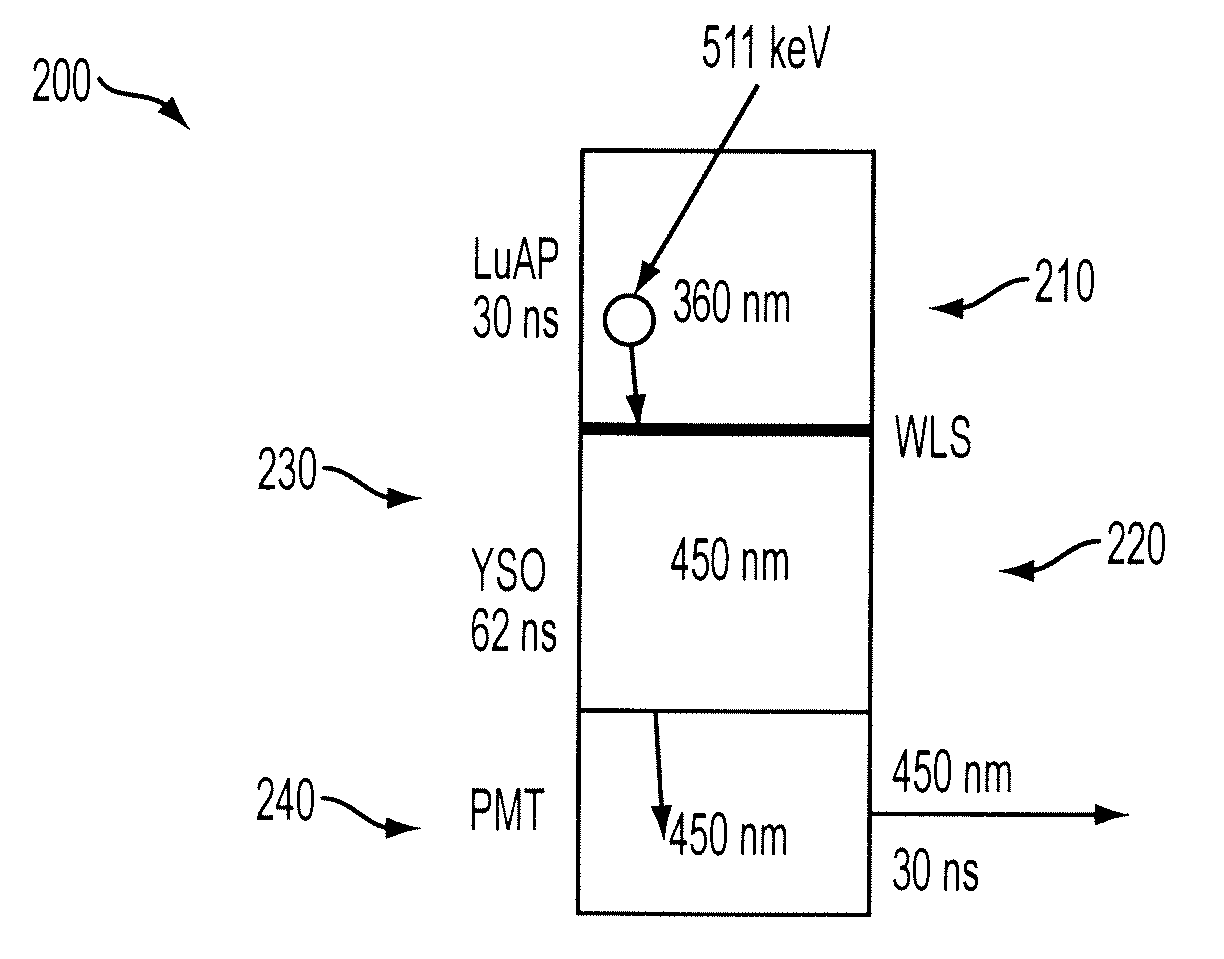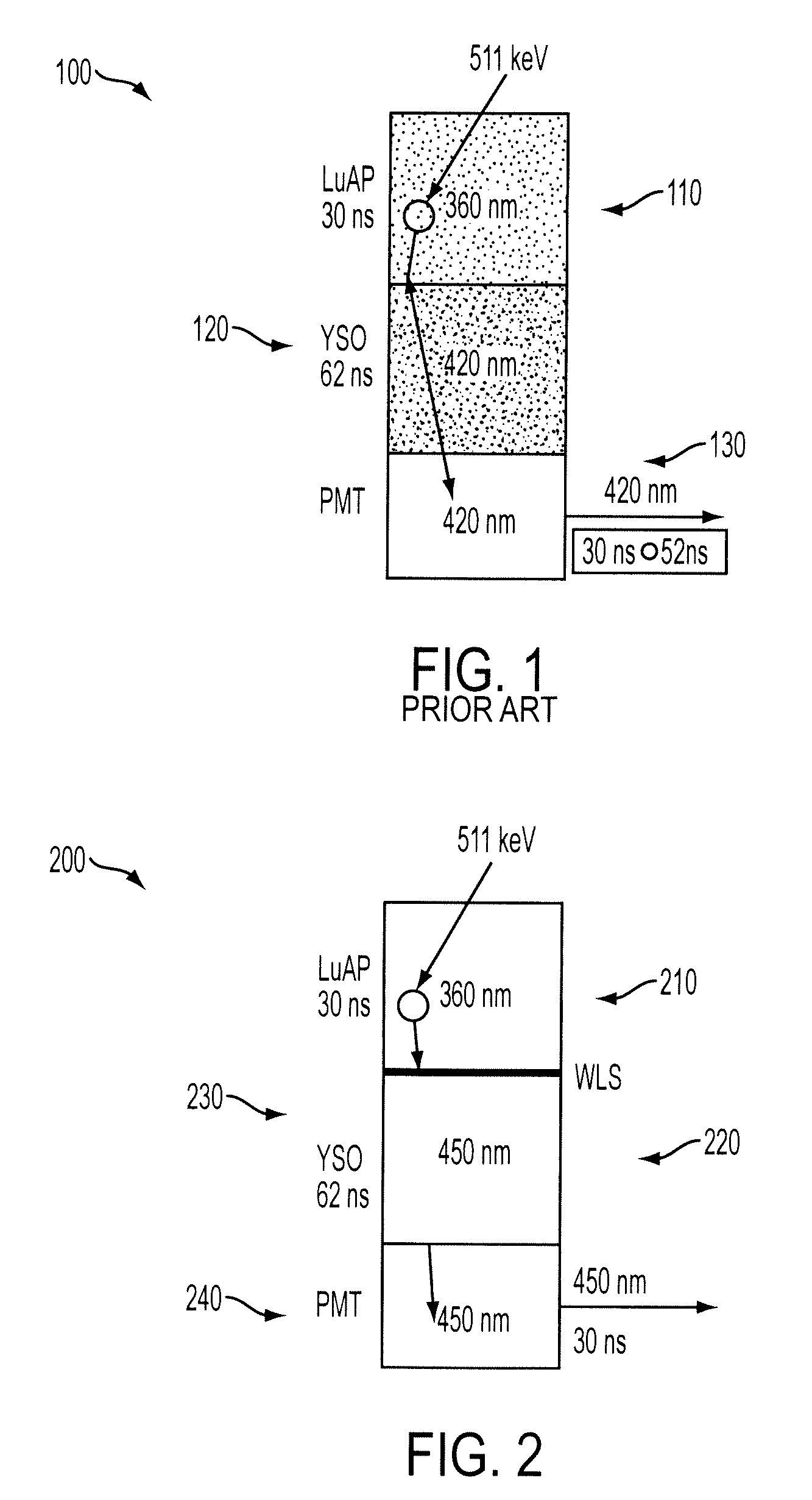Implementation of wavelength shifters in phoswich detectors
a detector and wavelength shifter technology, applied in the field of nuclear medical imaging, can solve the problems of reducing the spatial resolution of the scintillator, difficult to make a scintillator with good pet properties, and not being well matched for use with other silicon-based photodetectors
- Summary
- Abstract
- Description
- Claims
- Application Information
AI Technical Summary
Benefits of technology
Problems solved by technology
Method used
Image
Examples
first embodiment
[0026]FIG. 2 depicts the present invention, comprising a phoswich device 200. The phoswich device 200 includes a LuAP scintillator 210, a YSO scintillator 230, and a fast wavelength shifting layer 220 between the LuAP and YSO scintillators. When a 511 keV gamma photon is absorbed in the LuAP scintillator 210, it emits light scintillations around 360 nm. The light photons travel out of the LuAP scintillator 210 and are absorbed by fast wavelength shifting layer 220, which has a scintillation time of approximately 3 ns. The wavelength shifting layer 220 converts the LuAP light emission from 360 nm to 450 nm while still keeping most of the LuAP decay time characteristics. The converted 450 nm light travels through the YSO scintillator 230 without exciting any response from the YSO crystal as the 450 nm is outside of the YSO excitation band. The 450 nm light exits from the YSO crystal 230 and enters into the PMT 240. The PMT 240 thus sees 450 nm light with a decay time characteristic su...
third embodiment
[0031]Finally, FIGS. 7 and 8 relate to the invention, which is directed to a phoswich combination of LaBr3 and LSO, similar to the embodiment of FIG. 2. FIG. 7 shows a phoswich 700 with an LaBr3:Ce (0.5% Ce, 25 ns scintillation decay time) scintillator 710 directly coupled to an LSO:Ce scintillator 720. When a 511 keV gamma interacts with the LaBr3 scintillator, 360 nm light is produced, which is absorbed by and excites the LSO scintillator, producing 420 nm light which is seen by the PMT. On the other hand, when a 511 keV gamma photon is stopped by the LSO scintillator, it causes 420 nm light to be directly produced by the LSO scintillator. The scintillation time characteristics seen by the PMT 730 in this case thus are the convolved LaBr3-LSO pulse and the direct LSO:Ce pulse.
[0032]In FIG. 8 a phoswich 800 has a thin wavelength shifter 820 (WLS, e.g., Eljen EJ299-21) between an LaBr3:Ce (0.5% Ce, 25 ns scintillation decay time) scintillator 810 and an LSO:Ce scintillator 830. The ...
PUM
 Login to View More
Login to View More Abstract
Description
Claims
Application Information
 Login to View More
Login to View More - R&D
- Intellectual Property
- Life Sciences
- Materials
- Tech Scout
- Unparalleled Data Quality
- Higher Quality Content
- 60% Fewer Hallucinations
Browse by: Latest US Patents, China's latest patents, Technical Efficacy Thesaurus, Application Domain, Technology Topic, Popular Technical Reports.
© 2025 PatSnap. All rights reserved.Legal|Privacy policy|Modern Slavery Act Transparency Statement|Sitemap|About US| Contact US: help@patsnap.com



